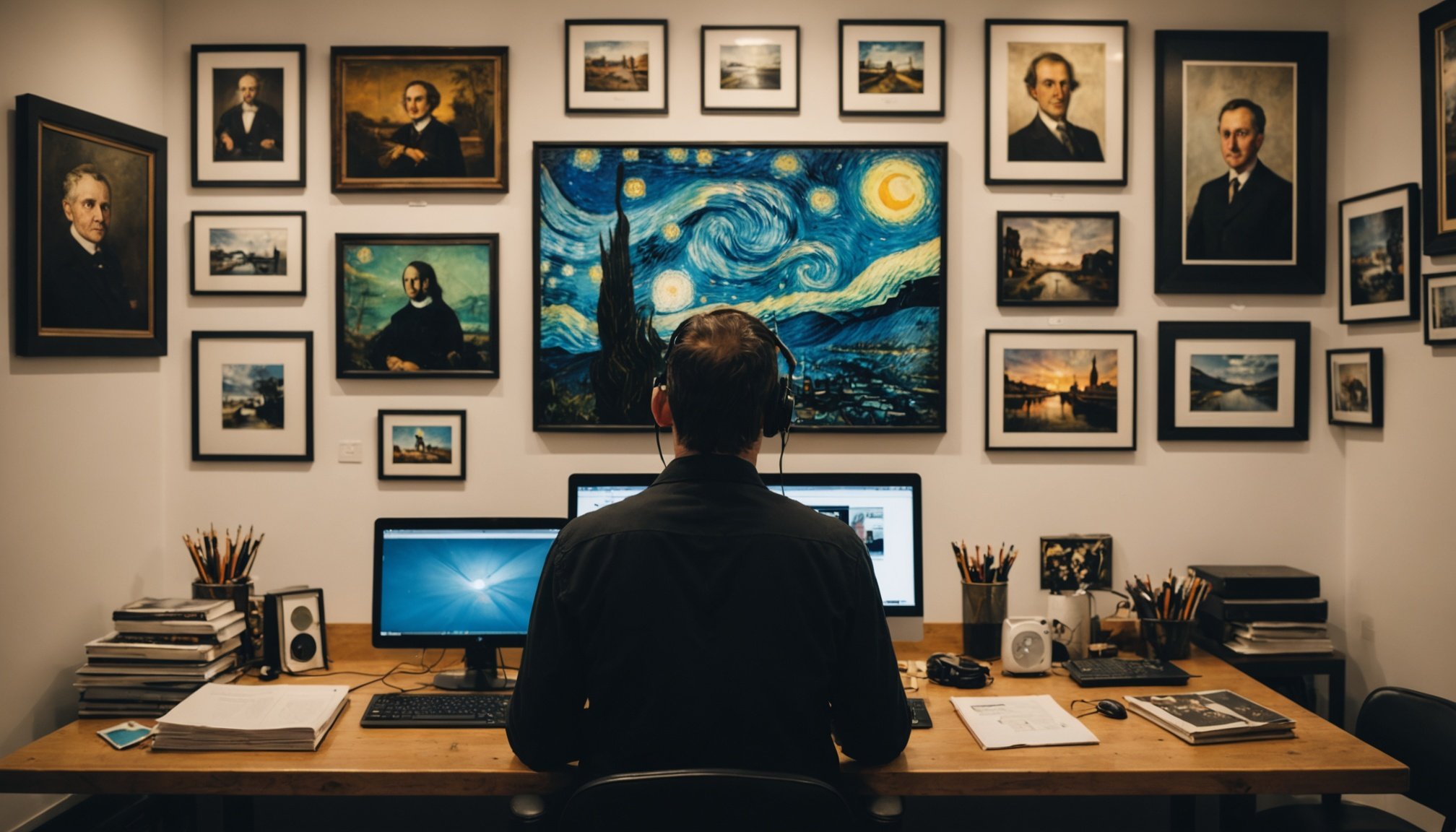Your Ultimate Guide to Starting a UK Online Art Gallery: Mastering Digital Copyright Laws for Success
Starting an online art gallery in the UK can be an exciting and rewarding venture, but it comes with its own set of challenges, particularly when it comes to navigating digital copyright laws. In this guide, we will walk you through the essential steps to ensure your art business thrives while respecting the intellectual property rights of artists and other stakeholders.
Understanding Digital Copyright Laws
Before you dive into the world of online art galleries, it’s crucial to understand the basics of digital copyright laws. Copyright law protects the intellectual property rights of creators, including artists, by giving them exclusive rights over their work.
What is Protected by Copyright?
- Original Literary, Dramatic, Musical and Artistic Works: This includes paintings, sculptures, photographs, and other forms of visual art.
- Sound Recordings: While not directly relevant to visual art, it’s important to know if you plan to use music in your marketing or events.
- Films and Broadcasts: If you plan to create videos showcasing your artwork, you need to be aware of these rights as well.
Key Principles of Copyright Law
- Ownership: The creator of the work is typically the copyright owner, unless the work is created under a contract that assigns ownership to another party.
- Duration: In the UK, copyright generally lasts for the lifetime of the author plus 70 years.
- Infringement: Using someone else’s copyrighted work without permission can lead to legal consequences.
| Aspect of Copyright Law | Description |
|
|-------------|
| Ownership | Typically belongs to the creator unless assigned otherwise. |
| Duration | Lifetime of the author plus 70 years in the UK. |
| Infringement | Using copyrighted work without permission can lead to legal action. |
Obtaining Necessary Permissions
To avoid copyright infringement, you need to obtain the necessary permissions from the artists whose work you plan to display and sell.
Licensing Agreements
- Exclusive vs. Non-Exclusive Licenses: Exclusive licenses grant you the sole right to use the artwork, while non-exclusive licenses allow the artist to license the work to others as well.
- Territorial Rights: Ensure the license covers the UK and any other territories where you plan to operate.
- Duration of License: Specify the period for which the license is valid.
Model Release Forms
- If the artwork features identifiable individuals, you may need model release forms to avoid privacy and defamation issues.
Example of a Licensing Agreement
**Licensing Agreement Example**
**Parties Involved:**
- **Licensor (Artist):** John Doe
- **Licensee (Gallery):** Your Art Gallery
**Scope of License:**
- The Licensor grants the Licensee a non-exclusive license to display and sell the artwork titled "Sunset" in the UK for a period of two years.
**Terms and Conditions:**
- The Licensee must credit the Licensor in all promotional materials.
- The Licensee must pay a royalty of 10% on each sale.
**Termination:**
- The license can be terminated by either party with 30 days' written notice.
Building Your Online Presence
Once you have the legal aspects covered, it’s time to build your online presence.
In parallel : Your ultimate blueprint for health and safety compliance in uk coworking spaces
Website Design and Development
- User-Friendly Interface: Ensure your website is easy to navigate and visually appealing.
- E-commerce Integration: Use a reliable e-commerce platform to facilitate smooth transactions.
- SEO Optimization: Optimize your website for search engines to improve visibility.
Digital Marketing Strategies
- Social Media Marketing: Use platforms like Instagram, Facebook, and Twitter to engage with your audience and showcase your artwork.
- Example: Create a Instagram series featuring the stories behind each artwork, using relevant hashtags to increase reach.
- Email Marketing: Build an email list and send regular newsletters to keep your audience informed about new artworks, events, and promotions.
- Tip: Use email marketing automation tools to personalize your emails and improve engagement.
- Content Marketing: Create blog posts, videos, and other content that adds value to your audience, such as art tutorials, artist interviews, and market trends.
| Digital Marketing Strategy | Description |
|
|-------------|
| Social Media Marketing | Engage with your audience on platforms like Instagram, Facebook, and Twitter. |
| Email Marketing | Build an email list and send regular newsletters to keep your audience informed. |
| Content Marketing | Create valuable content such as blog posts, videos, and art tutorials. |
Engaging with Your Audience
Engaging with your audience is crucial for building a loyal customer base and promoting your art business effectively.
Building a Community
- Social Media Groups: Create or join social media groups where art enthusiasts and collectors can discuss and share their love for art.
- Webinars and Online Events: Host webinars, artist talks, and virtual exhibitions to engage with your audience in real-time.
- Example: Collaborate with artists to host live painting sessions or Q&A sessions on social media.
Collecting Feedback
- Surveys and Reviews: Collect feedback through surveys and reviews to understand what your audience likes and what you can improve.
- Tip: Use this feedback to adjust your marketing strategies and improve customer satisfaction.
Leveraging Technology and Trends
The art market is evolving, and leveraging technology and current trends can give you a competitive edge.
Artificial Intelligence in Art
- AI-Generated Art: Consider showcasing AI-generated art, which is becoming increasingly popular.
- Example: Partner with AI artists to create unique pieces that blend human creativity with AI capabilities.
Sustainability and Ethical Considerations
- Eco-Friendly Practices: Adopt eco-friendly practices in your business operations, such as using sustainable materials for packaging and reducing digital carbon footprint.
- Quote: “Sustainability is not just a trend; it’s a necessity. As an art gallery, we have a responsibility to reduce our impact on the environment,” says Jane Smith, owner of GreenArt Gallery.
Soft Skills for Success
- Communication Skills: Develop strong communication skills to effectively work with artists, clients, and other stakeholders.
- Tip: Invest in courses or workshops that improve your negotiation and conflict resolution skills.
Navigating the Art Market
Understanding the art market is essential for the success of your online gallery.
Market Trends
- Emerging Artists: Keep an eye on emerging artists and trends in the art world.
- Example: Follow art critics, curators, and influencers on social media to stay updated on the latest trends.
- Collectors’ Preferences: Understand what collectors are looking for in terms of style, medium, and themes.
- Tip: Attend art fairs and exhibitions to network with collectors and gain insights into their preferences.
Pricing and Commission
- Pricing Strategies: Develop fair and transparent pricing strategies that benefit both the artist and the gallery.
- Example: Use a commission-based model where the gallery takes a percentage of the sale price.
- Transparency: Ensure transparency in your pricing and commission structures to build trust with artists and collectors.
| Market Trend | Description |
|
|-------------|
| Emerging Artists | Keep an eye on new and upcoming artists. |
| Collectors' Preferences | Understand what collectors are looking for in terms of style, medium, and themes. |
| Pricing Strategies | Develop fair and transparent pricing strategies. |
| Transparency | Ensure transparency in your pricing and commission structures. |
Starting an online art gallery in the UK requires a deep understanding of digital copyright laws, effective marketing strategies, and a strong online presence. Here are some key takeaways:
- Understand and respect copyright laws to avoid legal issues and protect the intellectual property of artists.
- Build a strong online presence through a user-friendly website and effective digital marketing strategies.
- Engage with your audience through social media, webinars, and other interactive events.
- Leverage technology and trends such as AI-generated art and sustainable practices to stay ahead in the market.
- Navigate the art market by staying updated on trends, understanding collectors’ preferences, and maintaining transparency in your business operations.
By following these guidelines, you can create a successful online art gallery that not only showcases beautiful artwork but also respects the rights of artists and contributes positively to the art world.
### Final Tips for Success
- **Stay Updated**: Continuously educate yourself on changes in copyright laws and market trends.
- **Network**: Build relationships with artists, collectors, and other galleries to stay connected within the art community.
- **Innovate**: Be open to new technologies and trends that can enhance your business and attract a wider audience.
- **Ethical Practices**: Always prioritize ethical considerations in your business operations to maintain a positive reputation.
By mastering these aspects, you can ensure your online art gallery thrives in the competitive UK art market.











